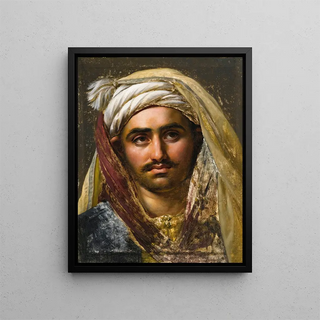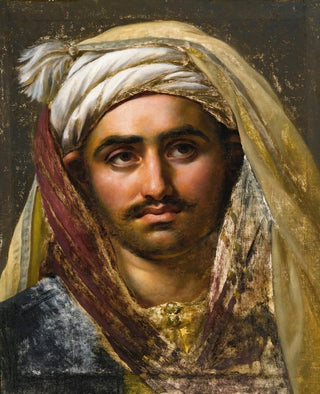Painting Head of a Young Turk - Anne-Louis Girodet-Trioson | Art print


View from behind

Frame (optional)
Art print Head of a Young Turk - Anne-Louis Girodet-Trioson – Captivating Introduction
In the artistic landscape of the early 19th century, Anne-Louis Girodet-Trioson stands out for his ability to capture the essence of the subjects he paints. His renowned work, "Head of a Young Turk," demonstrates an aesthetic sensitivity and psychological depth that transcend a simple portrait. Through this representation, Girodet invites the viewer to immerse themselves in a universe where beauty and exoticism meet, revealing the nuances of a rich and complex culture. The way he handles facial features and clothing details evokes a fascination with the Orient, while incorporating elements of French classical tradition. This work, both intimate and universal, captivates with its expressiveness and technical mastery.
Style and uniqueness of the work
Girodet's style is characterized by a keen sense of color and light, which give his portraits an almost dreamlike atmosphere. In "Head of a Young Turk," warm tones and delicate shadows create a play of light that highlights the fine features of the young man. The artist uses subtle nuances to evoke the texture of the skin, while the reflections in the eyes seem to vibrate with inner life. This work also stands out for its carefully balanced composition, where the face is centered, immediately drawing the viewer's attention. The clothing details, adorned with oriental motifs, add an extra dimension, emphasizing the harmony between the individual and their cultural heritage. Girodet thus manages to create a portrait that is not merely a representation but a true exploration of identity.
The artist and his influence
Anne-Louis Girodet-Trioson, a student of Jacques-Louis David, developed a personal style that combines neoclassicism and emerging romanticism. His career is marked by a series of emblematic works that testify to his exceptional talent and artistic innovation. Girodet was influenced by the ideals of the French Revolution, but also by scientific discoveries and cultural exchanges of his time. His approach to portraiture, which goes beyond mere physical representation, paved the way for many subsequent artists. By integrating exotic elements and

Matte finish

View from behind

Frame (optional)
Art print Head of a Young Turk - Anne-Louis Girodet-Trioson – Captivating Introduction
In the artistic landscape of the early 19th century, Anne-Louis Girodet-Trioson stands out for his ability to capture the essence of the subjects he paints. His renowned work, "Head of a Young Turk," demonstrates an aesthetic sensitivity and psychological depth that transcend a simple portrait. Through this representation, Girodet invites the viewer to immerse themselves in a universe where beauty and exoticism meet, revealing the nuances of a rich and complex culture. The way he handles facial features and clothing details evokes a fascination with the Orient, while incorporating elements of French classical tradition. This work, both intimate and universal, captivates with its expressiveness and technical mastery.
Style and uniqueness of the work
Girodet's style is characterized by a keen sense of color and light, which give his portraits an almost dreamlike atmosphere. In "Head of a Young Turk," warm tones and delicate shadows create a play of light that highlights the fine features of the young man. The artist uses subtle nuances to evoke the texture of the skin, while the reflections in the eyes seem to vibrate with inner life. This work also stands out for its carefully balanced composition, where the face is centered, immediately drawing the viewer's attention. The clothing details, adorned with oriental motifs, add an extra dimension, emphasizing the harmony between the individual and their cultural heritage. Girodet thus manages to create a portrait that is not merely a representation but a true exploration of identity.
The artist and his influence
Anne-Louis Girodet-Trioson, a student of Jacques-Louis David, developed a personal style that combines neoclassicism and emerging romanticism. His career is marked by a series of emblematic works that testify to his exceptional talent and artistic innovation. Girodet was influenced by the ideals of the French Revolution, but also by scientific discoveries and cultural exchanges of his time. His approach to portraiture, which goes beyond mere physical representation, paved the way for many subsequent artists. By integrating exotic elements and
12,34 €






